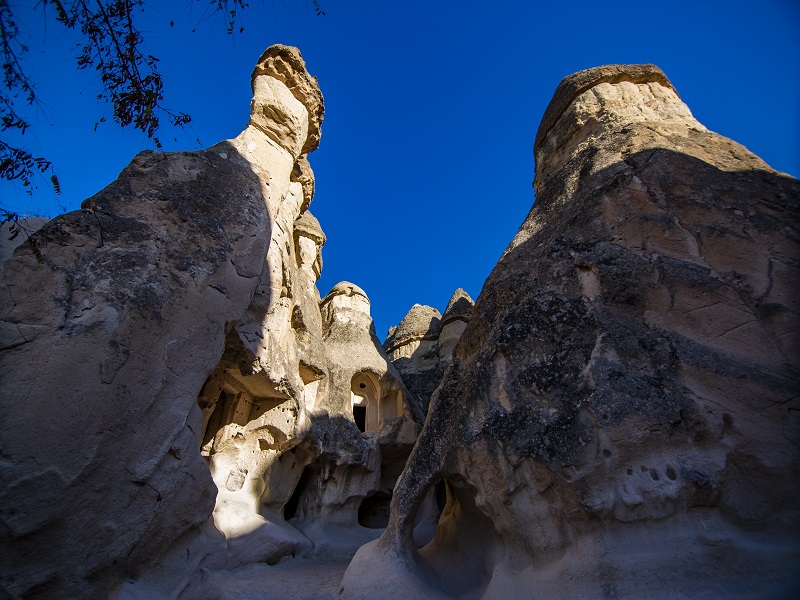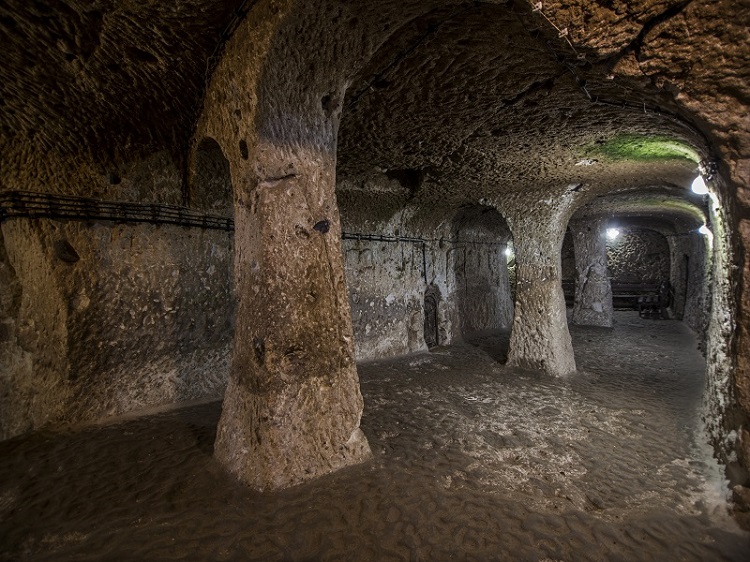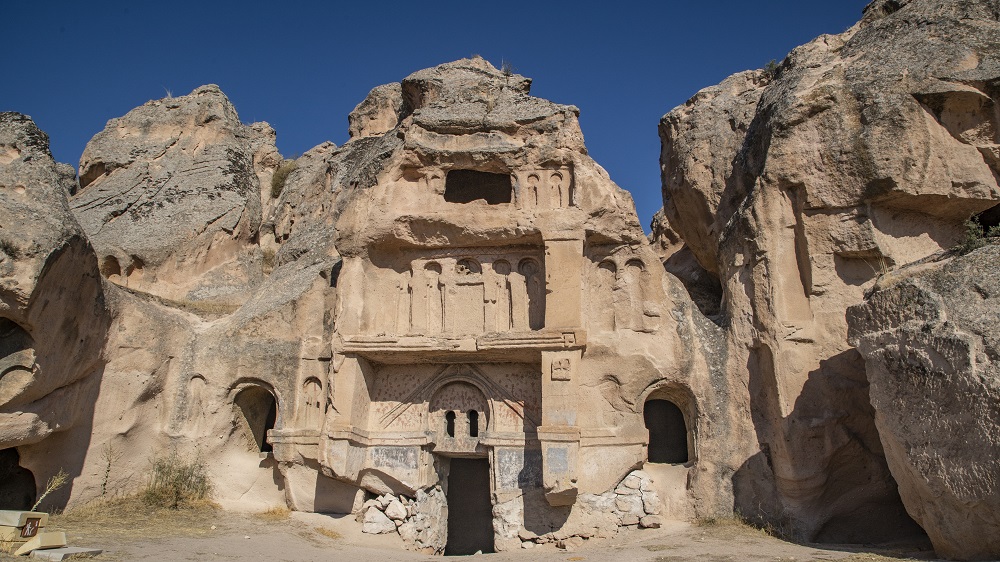Cappadocia Blue Tour
- A
- Kaymaklı Underground City
- Kaymakli, one of the major underground cities of Cappadocia, consists of 8 floors. However, as in many underground cities, not all floors are open to tourists. In the city, the first floor is separated for the animals to go out easily. Establish a connection between the churches and other living spaces with the corridors separated from the stables. Kaymakli Underground City, which has astounding sections such as warehouses, kitchens, cemeteries, mughouse, and copper processing workshop, still contains hidden underground tunnels that have not been fully revealed. For further information and e-ticket please visit click here.Read More
- Nasıl
Giderim ?
- B
- Three Beauties Fairy Chimneys
- Ürgüp - One of the most important symbols of Cappadocia, the Legend of Three Beauties takes its name from the fairy chimney of two adults and a child. So why have we defined these fairy chimneys as adults and a child? When you learn the legend, you will fully understand what we mean. Rumor has it that a king and princess lived in Cappadocia. The beautiful princess, the daughter of the king, fell in love with a shepherd. However, the king can not give approval for this love. Because the person she falls in love with is a shepherd. The arrogant king, who does not want to marry his princess girl with a shepherd and opposes his daughter to marry despite all her insistence. Realizing that she can not convince her father, the princess runs away with her beloved one night. After the escape, the shepherd and the noble young girl also have a child. After all, the princess considers visiting her father, thinking that the stubbornness of the king will be broken after the baby is born. However, the cruel king, who learns that he has a grandson, gets even angrier and maddened. He instructs his soldiers to find the daughter and the shepherd. The poor princess and her family, who are cornered by the soldiers who follow them, realize that they can no longer escape. At that moment, she prayed to God and made a preacher and waited for a miracle for her family to stay together. In the fairy tale, the princess's wish came true and all the family turned into immortal fairy chimneys. It is believed that the foremost is the shepherd, the middle one is the child, and the one in the back is the princess. In this story, the Three Beauties, which is thought to be symbolizing the family, were believed that the families without children would come here and have children by going up and down the slope next to these fairy chimneys 7 times. According to another legend, it is a love story in which they could not come together and the friendship of fairies and people. Evil giants living in Cappadocia used to scare people by blowing flames over the mountains and burning their houses. The sultan of the fairies, who happen to pass through the Cappadocia Three Beauties region, wanted to help people when he saw this situation. The fairies managed to extinguish the fire with the ice and snow they brought from the top of the mountains by working for days. After the giants entered the underground, a warm ambiance formed between humans and fairies. And fairies started living in fairy chimneys as neighbors with people. After a while, the son of the king "Revan" and the daughter of the fairy sultan "Gülperi" fell in love. However, people decided to frown on this love and fight fairies. The sultan left Cappadocia because he did not want to fight people. However, thinking that people can not cope with giants, he ordered all fairies to be pigeons and stay with them. Gülperi also turned into a white dove and settled on the window of Revan's room every day. Revan, unaware of what happened, thought she abandoned him. He waited until the end of his life. He took the pigeon on his palms and met his longing for Gülperi with love and caressed her. These 3 fairy chimneys, which are the most important figures of Cappadocia, are one of the most photographed places in the region. The bodies that turn to stone get a very artistic and lively appearance, especially with the night lighting. Including the view of the imposing Mount Erciyes, Three Beauties presents a fascinating palette of colors that breathtaking at sunset.Read More
- Nasıl
Giderim ?
- C
- Mustafapasa (Sinasos) Village
- Mustafapaşa Town, which is among the untouched destinations of Cappadocia and not within 6 kilometers of Ürgüp and 25 kilometers from Nevşehir, is a Greek Village, formerly known as "Sinasos". This charming village, which is one of the must-see places in Cappadocia, is becoming popular with its history of rupture and its architectural features. It is possible to come across impressive churches and chapels in Mustafapaşa Town. St. Vasilios, St. Stephen's Churches and St. Basil's Chapel, which hosted the Christian people until 1924 when the population change took place, created a dazzling effect. As a result of the fact that many civilizations have made this place home throughout history, it is possible to come across original examples of Seljuk and Ottoman architecture at the destination. Mustafapaşa Village is one of the regions rich in places to visit. It is recommended to allocate time for destinations such as St. Nicholas Monastery, Mehmet Şakirpaşa Madrasa, Constantine Helena Church, Cappadocia Art and History Museum in the town, which is a must-see tour in Cappadocia. It can be said that stone mansions, which have become icons from the past to the present, also create a fascinating atmosphere for visitors.Read More
- Nasıl
Giderim ?
- D
- Sobesos Ancient City
- Sobesos Ancient City was discovered by accident in 2002. The city, which is one of the mirrors of Cappadocia's history, was unearthed as a result of a 3-year archaeological excavation. As a result of the excavations, it has been observed that there are many motifs embroidered on colored stones. Especially the floor mosaics are made with interesting geometric patterns. As a result of the motifs and the general architecture of the building, it was understood that it was from the Roman period. Although the exact boundaries of the city cannot be drawn, an administrative center, bathhouse, cemeteries and chapel have come to light. The meeting room covers an area of approximately 400 meters. The origin of the name Sobesos is based on the native people of Anatolia, Luwi. The original name of the city, Swa, is derived from Assa / Assos oges. The city was called Sobesos / Sobessos during the Roman and Byzantine periods with the changes its name went through in the following years. Sobesos Ancient City is located in the region called Örencik by the villagers, near the source point of Damsa Stream, south of Şahinefendi Village of Ürgüp. It was strategically built on an area with very safe and fertile landRead More
- Nasıl
Giderim ?
The Most Popular Routes in Cappadocia
 Loading...
Loading...






 cappadocia
cappadocia




